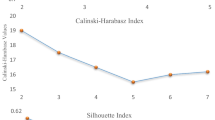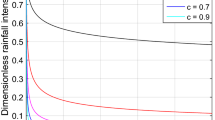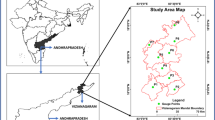Abstract
Intensity–Duration–Frequency (IDF) curves are known as practical tools in the construction of infrastructures. However, developing such curves is restricted in many regions due to sparse and insufficient record length of in-site rainfall observations. It is hence recommended to generate the regional curves. According to the hydro-climate variability and change during the recent decades, it is essential to consider the non-stationarity of hydro-climate variables. In this research, the Neural Gas network (NGN) coupled with ProNEVA have been applied to develop non-stationary regional IDFs. The l-moments approach was used to plot regional stationary IDF curves to compare the results of non-stationary IDFs for homogenous regions. The results showed that the regional nonstationary curves had overestimated rainfall intensity compared with the regional stationary curves which can attribute to the decreasing trend of rainfall over the study area. The average value of overestimation in the return period of 2 years was equal to 50 percent. This overestimation was more significant for lower return periods, which indicates that the nonstationary approach is more important for short-duration events. The return period of 100 years is equal to 25 percent in region two, and in region one, it is equal to 20 and 43 percent, respectively.






Similar content being viewed by others
Availability of Data and Material
Not applicable.
Code Availability
Not applicable.
References
Abdi A, Hassanzadeh Y, Ouarda TB (2017) Regional frequency analysis using Growing Neural Gas network. J Hydrol 550:92–102
Agilan V, Umamahesh NV (2016) Is the covariate based non-stationary rainfall IDF curve capable of encompassing future rainfall changes? J Hydrol 541:1441–1455
Aho K, Derryberry D, Peterson T (2014) Model selection for ecologists: the worldviews of AIC and BIC. Ecology 95(3):631–636
Akaike H (1974) A new look at the statistical model identification. IEEE Trans Autom 19(6):716–723
Alemaw BF, Chaoka RT (2016) Regionalization of rainfall intensity-duration-frequency (IDF) curves in Botswana. J Water Resour Prot 8(12):1128
Asadieh B, Krakauer NY (2015) Global trends in extreme precipitation: climate models versus observations. Hydrol Earth Syst Sci 19(2):877–891
Blanchet J, Ceresetti D, Molinié G, Creutin JD (2016) A regional GEV scale-invariant framework for Intensity–Duration–Frequency analysis. J Hydrol 540:82–95
Caliński T, Harabasz J (1974) A dendrite method for cluster analysis. Commun Stat-Theory Methods 3(1):1–27
Cavanaugh NR, Gershunov A, Panorska AK, Kozubowski TJ (2015) The probability distribution of intense daily precipitation. Geophys Res Lett 42(5):1560–1567
Cheng L, AghaKouchak A (2014) Nonstationary precipitation intensity-duration-frequency curves for infrastructure design in a changing climate. Sci Rep 4(1):1–6
Chou CH, Su MC, Lai E (2004) A new cluster validity measure and its application to image compression. Pattern Anal Appl 7(2):205–220
Dixit S, Jayakumar KV (2022) A non-stationary and probabilistic approach for drought characterization using trivariate and pairwise copula construction (PCC) model. Water Resour Manag 36(4):1217–1236
Fritzke B (1995) A growing neural gas network learns topologies. Neur Inf Sys 625–632
Ganguli P, Coulibaly P (2017) Does nonstationarity in rainfall require nonstationary intensity–duration–frequency curves? Hydrol Earth Syst Sci 21(12):6461–6483
Gao M, Mo D, Wu X (2016) Nonstationary modeling of extreme precipitation in China. Atmos Res 182:1–9
Gilks WR, Richardson S, Spiegelhalter D (1995) Markov chain Monte Carlo in practice. CRC Press
Gohari A, Shahrood AJ, Ghadimi S, Alborz M, Patro ER, Klöve B, Haghighi AT (2022) A century of variations in extreme flow across Finnish rivers. Environ Res Lett 17(12):124027
Hardy JT (2003) Climate change: causes, effects, and solutions. John Wiley & Sons
Hosking JR (1990) L-moments: Analysis and estimation of distributions using linear combinations of order statistics. J R Stat Soc: Series B (methodological) 52(1):105–124
Hosking JRM, Wallis JR (1993) Some statistics useful in regional frequency analysis. Water Resour Res 29(2):271–281
Jamali M, Gohari A, Motamedi A, Haghighi AT (2022) Spatiotemporal changes in air temperature and precipitation extremes over Iran. Water 14(21):3465
Kendall M (1962) Rank CorrelationMethods, 3rd edn. Hafner PublishingCompany, New York
Lee SH, Maeng SJ (2003) Frequency analysis of extreme rainfall using L-moment Irrigation and Drainage. The Journal of the International Commission on Irrigation and Drainage 52(3):219–230
Lenderink G, Van Meijgaard E (2008) Increase in hourly precipitation extremes beyond expectations from temperature changes. Nat Geosci 1(8):511–514
Li J, Lei Y, Tan S, Bell CD, Engel BA, Wang Y (2018) Nonstationary flood frequency analysis for annual flood peak and volume series in both univariate and bivariate domain. Water Resour Manage 32:4239–4252
Lima CH, Kwon HH, Kim JY (2016) A Bayesian beta distribution model for estimating rainfall IDF curves in a changing climate. J Hydrol 540:744–756
Mahmoudi MR, Eslamian S, Soltani S, Tahanian M (2023) Correction to: Regionalization of rainfall intensity–duration–frequency (IDF) curves with L-moments method using neural gas networks. Theoret Appl Climatol 51(1–2):1–11
Mann HB (1945) Nonparametric tests against trend Econometrica. J Econom Soc 245–259.
Mohan MG, AR A, Krishnan A, Rajan A (2023) Hydrologic regionalization of non-stationary intensity–duration–frequency relationships for Indian mainland. H2Open J 6(2):223–241
Motamedi A, Gohari A, Haghighi AT (2023) Three-decade assessment of dry and wet spells change across Iran, a fingerprint of climate change. Sci Rep 13(1):p2888
Overeem I, Syvitski JP (2010) Shifting discharge peaks in Arctic rivers, 1977–2007. Geogr Ann Ser A Phys Geogr 92(2):285–296
Perica S, Dietz S, Heim S, Hiner L, Maitaria K, Martin D, Pavlovic S, Roy I, Trypaluk C, Unruh D, Yan F (2011) Precipitation-Frequency Atlas of the United States Volume 6 Version 23, California
Ragno E, AghaKouchak A, Cheng L, Sadegh M (2019) A generalized framework for process-informed nonstationary extreme value analysis. Adv Water Resour 130:270–282
Rao AR, Hamed KH (1997) Regional frequency analysis of Wabash River flood data by L-moments. J Hydrol Eng 2(4):169–179
Rosner A, Vogel RM, Kirshen PH (2014) A risk-based approach to flood management decisions in a nonstationary world. Water Resour Res 50:1928–1942
Rousseeuw PJ (1987) Silhouettes: a graphical aid to the interpretation and validation of cluster analysis. J Comput Appl Math 20:53–65
Sarhadi A, Soulis ED (2017) Time-varying extreme rainfall intensity-duration-frequency curves in a changing climate. Geophys Res Lett 44(5):2454–2463
Schwarz G (1978) Estimating the dimension of a model. Ann Stat 461–464
Singh D, Horton DE, Tsiang M, Haugen M, Ashfaq M, Mei R, Rastogi D, Johnson NC, Charland A, Rajaratnam B, Diffenbaugh NS (2014) Severe precipitation in Northern India in June 2013: Causes, historical context, and changes in probability Bull Am. Meteorol Soc 95(9):S58–S61
Smith RL (2001) Extreme value statistics in meteorology and the environment. Environ Stat 8:300–357
Tramblay Y, Neppel L, Carreau J, Sanchez-Gomez E (2012) Extreme value modelling of daily areal rainfall over Mediterranean catchments in a changing climate. Hydrol Process 26(25):3934–3944
Tsakiris GP, Loucks DP (2023) Adaptive water resources management under climate change: An introduction. Water Resour Manag 1–13
Vasiliades L, Galiatsatou P, Loukas AJ (2015) Nonstationary frequency analysis of annual maximum rainfall using climate covariates. Water Resour Manag 29:339–358
Veneziano D, Yoon S (2013) Rainfall extremes, excesses, and intensity-duration-frequency curves: A unified asymptotic framework and new nonasymptotic results based on multifractal measures. Water Resour Res 49(7):4320–4334
Villarini G, Serinaldi F, Smith JA, Krajewski WF (2009) On the stationarity of annual flood peaks in the continental United States during the 20th century. Water Resour Res 45(8)
Westra S, Fowler HJ, Evans JP, Alexander LV, Berg P, Johnson F, Kendon EJ, Lenderink G, Roberts N (2014) Future changes to the intensity and frequency of short-duration extreme rainfall. Rev Geophys 52(3):522–555
Xu L, Zhou H, Du L, Yao H, Wang H (2015) Precipitation trends and variability from 1950 to 2000 in arid lands of Central Asia. J Arid Land 7(4):514–526
Yang L, Li J, Kang A, Li S, Feng P (2020) The effect of nonstationarity in rainfall on urban flooding based on coupling SWMM and MIKE21. Water Resour Manag 34:1535–1551
Yue S, Pilon P, Cavadias G (2002) Power of the Mann-Kendall and Spearman’s rho tests for detecting monotonic trends in hydrological series. J Hydrol 259(1–4):254–271
Acknowledgements
The authors appreciate the constructive comments of anonymous reviewers on this paper, which helped improve the final version of the paper.
Funding
This research received no external funding.
Author information
Authors and Affiliations
Contributions
All authors collaborated in the research presented in this publication by making the following contributions: research conceptualization, Mohammad Reza Mahmoudi (M.R.M.), Moein Tahanian (M.T.), Alireza Gohari (A.G.), Saeid Eslamian (S.E.); methodology, M.R.M., A.G., and S.E.; formal analysis, M.R.M, A.G., and S.E; writing—original draft preparation, M.R.M, M.T., and A.G.; writing—review and editing, M.R.M, M.T., and A.G.; supervision, A.G. and S.E.,
Corresponding author
Ethics declarations
Ethics Approval
We confirm that this article is original research and has not been published or presented previously in any journal or conference in any language.
Consent to Participate
Not applicable.
Consent for Publication
All the authors consented to publish the paper.
Conflict of Interest
The authors declare that they have no conflict of interest.
Additional information
Publisher's Note
Springer Nature remains neutral with regard to jurisdictional claims in published maps and institutional affiliations.
Rights and permissions
Springer Nature or its licensor (e.g. a society or other partner) holds exclusive rights to this article under a publishing agreement with the author(s) or other rightsholder(s); author self-archiving of the accepted manuscript version of this article is solely governed by the terms of such publishing agreement and applicable law.
About this article
Cite this article
Mahmoudi, M.R., Tahanian, M., Gohari, A. et al. Developing the Regional Nonstationary IDF Curves Using NGN-ProNEVA Framework. Water Resour Manage 37, 5581–5599 (2023). https://doi.org/10.1007/s11269-023-03619-5
Received:
Accepted:
Published:
Issue Date:
DOI: https://doi.org/10.1007/s11269-023-03619-5




